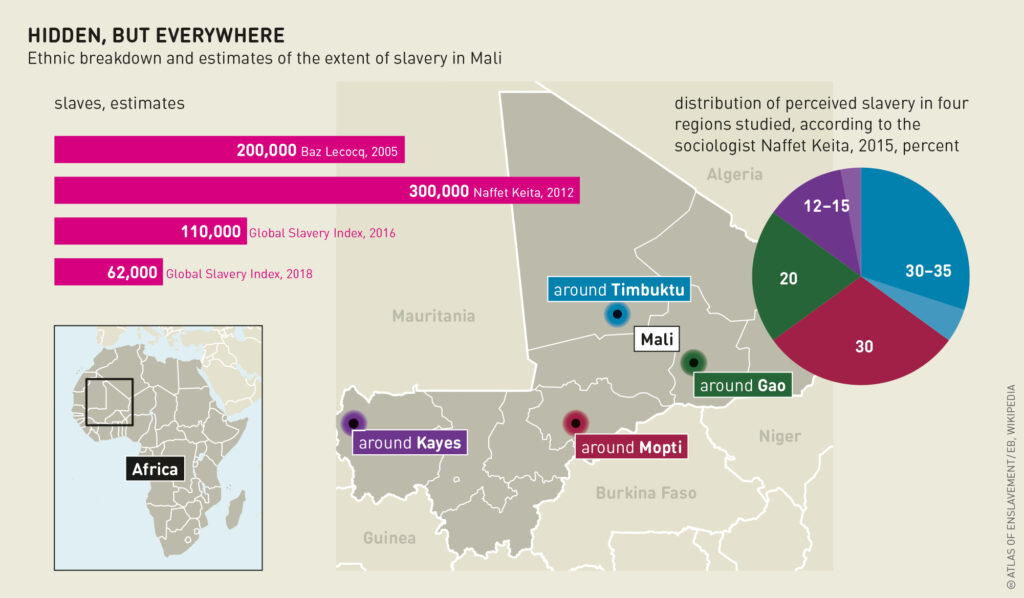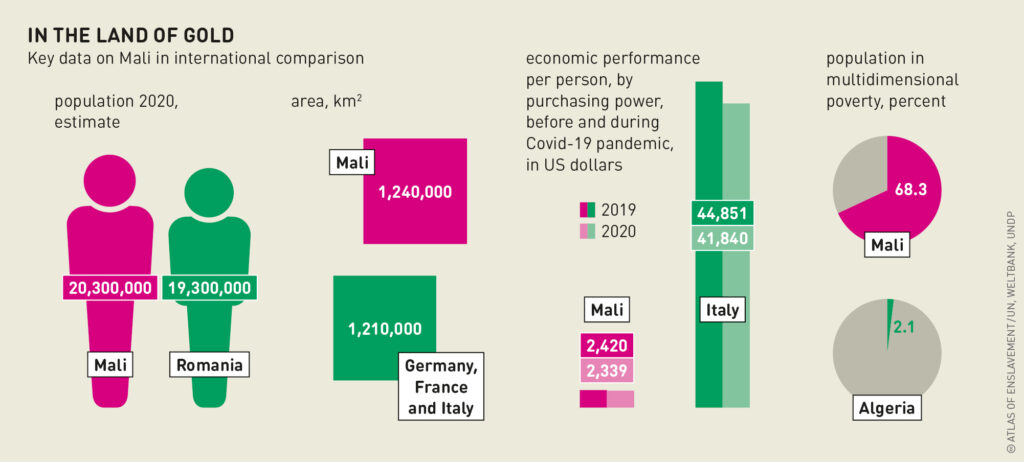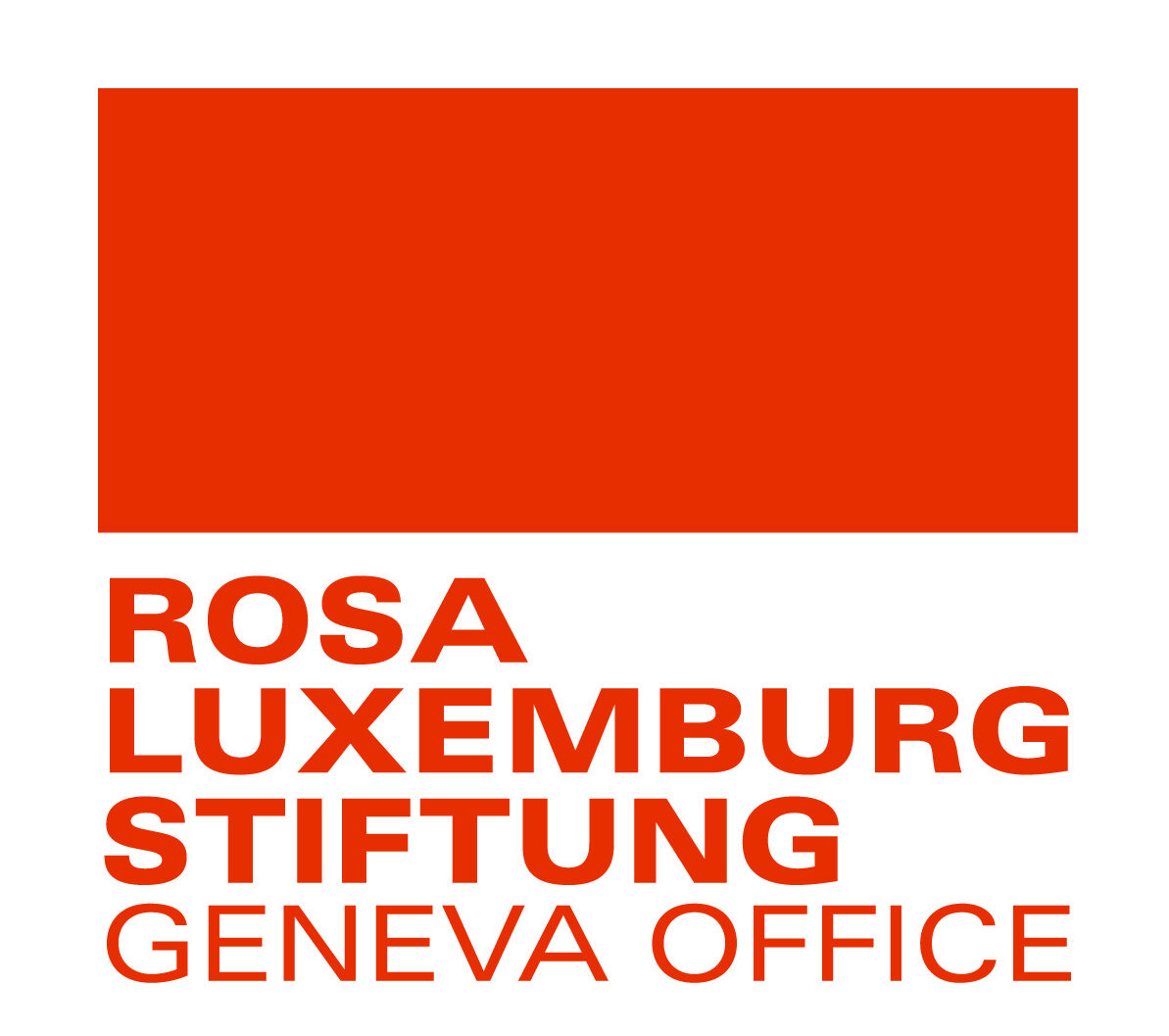In parts of Mali, some citizens’ fates are decided before they are born. Babies born to slave mothers are destined themselves to become slaves. Society is stratified into castes, with slaves at the bottom.
Addressing the question of slavery in today’s Mali must start by identifying situations where people are exploited without the chance of opposing their situation or escaping from it. Naffet Keita, a researcher at the University of Bamako, gives a figure of 300,000 full-fledged slaves in Mali, but says the number is 850,000 if their descendants and emancipated slaves are included.

Slavery has a centuries-long history in Mali. At its peak in the 14th century, the Mali Empire covered not just a large part of modern Mali but also all or part of The Gambia, Guinea, Mauritania and Senegal. Its founder, the emperor Soundiata Keita (1190–1255) tried in the 13th century to regulate the issue of slavery through the charter of Kouroukan Fouga. This reflects the long-standing nature of the practice in West Africa.
Slavery arose in several parts of what is now Mali. The ethnologist Yaya Sy has analysed the case of “internal” slavery in the west, in the area inhabited by the Soninké people. He believes that slavery in the area predates the first contacts between West Africa and the Arab-Muslim world in the 7th to 11th centuries. In the centre-east, the anthropologist Gilles Holder describes a “slave society” among the Saman that settled in the Dogon region of central Mali between the 15th and 18th centuries. The anthropologist Jean Bazin identified the existence of two categories of slaves in the kingdom of Segou, established in the 18th century in part of present-day Mali: those belonging to the community (known as forobajon) who joined the army, and those assigned to do domestic work.

The growth of the triangular trade of slaves, manufactured goods and sugar across the Atlantic, which lasted until the 19th century, helped maintain a measure of legitimacy for slavery as an institution. It was only with the decree by the colonial administration on 12 December 1905 that slavery was officially abolished in French West Africa. The Malian constitution now states that “the human person is sacred and inviolable” and that “every individual has the right to life, liberty, security and personal integrity” (Article 1). This text adds that “all Malians are born and remain free and equal in rights and duties” (Article 2). Nonetheless, numerous experts and United Nations Special Rapporteurs, academics and civil society organizations denounce the descent-based slavery that persists to this day.
Despite the principle of equality among citizens laid down by the constitution, slavery continues in Mali among certain ethnic groups because society is divided into hierarchical categories that are regarded as homogenous. The groups that practise this social stratification include the Soninké, Malinké and Peul, which are divided into nobles, artisans, griots and slaves. The words used to identify slaves vary between groups. Among the Touareg, for example, the slave class is called “Bellas”, while among the Bambara it is the “Dyons”. The Soninké call slaves “komo”. This social group itself is subdivided according to the assignment of the individuals and the master to whom they are attached.
This form of slavery, organized today within ethnic groups, is essentially based on descent. Naffet Keita explains that servile status is transmitted from mother to child. Yaya Sy and Claude Meillassoux talk about this “mother’s foot” rule that each slave is subject to after birth. In practice, slaves are assigned to menial tasks, such as service during wedding or baptism ceremonies. They are not permitted to marry nobles or their descendants. They are not allowed to run for political office, and they may not lead prayers. Moreover, in some ethnic groups, those who try to contest their status may be bullied into submission, sometimes to death.

In 2018, the Office of the UN High Commissioner for Human Rights pointed out that discrimination against certain ethnic groups or social categories still persisted in Mali, especially in certain Touareg communities. Touareg society is made up of clans that are structured along rigid hierarchical lines, with the darker-skinned Bellas at the bottom of the social scale. They are denied the dignity and rights accorded to them as human beings.
Unlike the neighbouring countries of Mauritania and Niger, Mali has not passed a specific law to fight slavery. An attempt to draft such a law was made between 2013 and 2017, but it was not successful. The degree of resistance to this attempt might be explained by the concerns that it raised among the country’s various ethnic groups.
